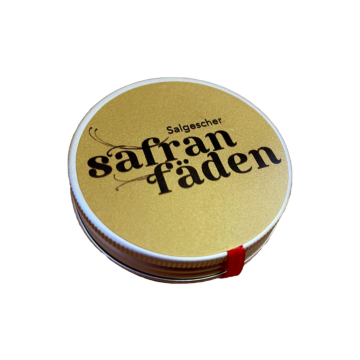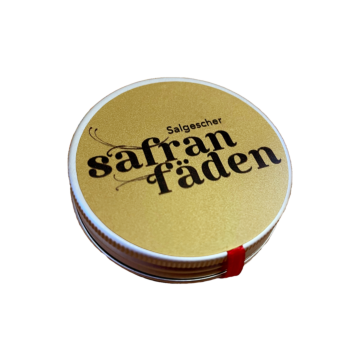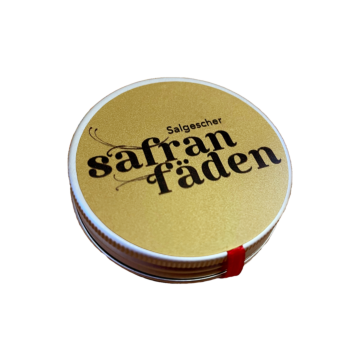The history of the origin of Salgesch saffron
The climatic conditions in the Rhone Valley are not only favourable for wine growing in the Valais. Saffron also thrives here, and so the owner of Blumen Gschwend came up with the idea of starting a project with Diego Mathier during a visit to the picturesque wine village of Salgesch. This project is otherwise only practised in Thurgau in Switzerland: the cultivation of saffron in the vineyards.
The geological and climatic conditions are not the only ideal factors. Thanks to saffron's characteristic as an anti-cyclical growth plant, the sustainable cultivation of one and the same area is carried out completely independently of each other by two different trades. During the dead season of the vines after the harvest in September, Viktor Gschwend and his team come to our vineyards to harvest the precious threads of saffron. And while the saffron plant is in hibernation, Diego Mathier and his team carry out the necessary work in the vineyards to ensure that another excellent vintage can be pressed. In addition, planting saffron bulbs in the vineyard also helps to prevent erosion and promotes organic farming, as the vineyard is weeded exclusively by hand.
The right plot was quickly found: located 300 metres from the winery, no fewer than 25,000 saffron bulbs are planted on the ‘Alte Sage’ plot. The plot faces due west and is therefore ideal for growing saffron, which needs the intense Valais afternoon sun to flourish, especially in winter.
An ideal place, therefore, where the liquid gold and the red gold enter into a perfect marriage. And not least because, at the latest after they have reached full maturity, both products combine at home at the dining table or in the restaurant to create a new taste explosion: as an excellent Mathier wine and as a delicate spice in the prepared dishes.
Harvest
The harzest takes place in autumn in October/November. It should only be carried out when the flowers are closed and always very early in the morning. If the temperature rises above 13-14 degrees during the day, the flowers will open, which will affect the quality of the saffron.
At the beginning of the harvest season, only a few hundred flowers are harvested daily; during the most intensive period of the harvest phase, this can easily be up to 25,000 flowers, depending on the size of the growing area. Planning the harvest is very difficult because the flowers emerge from the soil at night, so it is not possible to know the night before how many will be out the next morning and how many harvesters will be needed. Once they arrive in a warm environment, the flowers open and the saffron threads can be removed.
Between 150,000 and 200,000 flowers are needed to produce one kilogram of saffron, and these are planted in an area of around 10,000 square metres. Since the harvest can only be done by hand, it is extremely laborious. An experienced picker can manage just sixty to eighty grams of flowers per day.
Saffron in the kitchen
First the good news: you don't have to be a top chef, because cooking with saffron is basically very easy. However, whether you are cooking at home or in a top restaurant, the same rule applies with saffron:
as you know, less is more. We recommend this not only to save you money, but more for flavour reasons. Saffron has a very intense flavour of its own and can easily overpower other ingredients if used in too large quantities. Careful dosing is therefore called for.
However, to allow it to develop its full effect, it is recommended to freshly grind the saffron (alternatively, you can also crush it between your fingers, although then your fingers will also become intensely coloured). Afterwards, the saffron should be soaked in lukewarm fresh water for 24 hours before cooking and only then used. It also combines very well with grape seed oil and is perfect for refining dishes with a light, creamy sauce.
Saffron as a medicinal plant
In medicine, saffron is known not only for its mood-enhancing but also for its highly aphrodisiac effect and can also be used as an anti-stress agent. Recent studies have shown that the safranal it contains increases serotonin levels comparable to synthetically produced drugs, but without any of the undesirable side effects.
Popularly known as the spice of joy, saffron can be used to treat severe depression or PMS and also contains antioxidant substances that have an anti-inflammatory and anti-cancer effect. Another reason why Cleopatra may have been so fond of saffron could be that it is said to have an appetite-suppressing effect...
Side effects of saffron
As is so often the case in life, saffron is one of those luxury foods that should not be enjoyed in moderation. The reason is not so much that you could end up overburdening your wallet more than your health, but rather that the spice is highly toxic per se. Just 20 grams can kill a person (although, given the price of saffron at the market, this is of course highly unlikely). If you were to ingest more than 5 grams of saffron, you would experience symptoms such as colic, spontaneous bleeding of the skin and mucous membranes, dizziness or stomach upset. However, the risk is negligible, as commercial saffron packs usually contain a maximum of 0.125 grams.
Saffron and wine
The basics of saffron and wine pairing
Of course, the basic rule is: anything goes. And at the end of the day, your taste is what counts. To ensure that you enjoy the combination of saffron and wine, and to really get the most out of a dish prepared with saffron, there are a few simple rules to follow:
- Saffron & white wine: As a general rule, choose a dry white wine. For example, a dry white wine with a slight bitterness goes well with a saffron risotto. A fine Petite Arvine, such as our Petite Arvine Les Pyramides, is a great way to discover a dish with saffron sauces.
- Saffron & red wine: tannic heavyweights have no place with this fine spice. Instead, the rule here is: the rounder, softer, more balanced and smoother, the better (for you and for the saffron). For example, the Merlot Nadia Mathier.
Frequently asked questions about saffron
How many flowers are needed for 1kg of saffron?
Between 150,000 and 200,000 flowers need to be harvested to produce a kilogram of saffron.
Why is saffron so expensive?
Due to the extremely low yield per flower and the laborious harvesting and processing, saffron is very expensive.
What is saffron used for?
Saffron can be used both in the kitchen and as a medicinal plant. In both cases, a sparing dosage is recommended, as saffron has a very strong flavour of its own and can cause serious damage to health if consumed in too large quantities (as little as 5g).
What is saffron good for?
Saffron is used to refine dishes in both simple and high-end gastronomy. Common dishes include saffron risotto, piccata Milanese with saffron sauce, and saffron desserts. As a medicinal plant, saffron has a strong mood-lifting, antidepressant effect and is effective for PMS. Thanks to its oxidative ingredients, it also has an anti-inflammatory and anti-cancer effect.
How do I use saffron in the kitchen?
Thanks to its intense flavour, saffron should only ever be used in the smallest of doses. It is best to crush the fresh saffron in a mortar and let it steep in slightly sweetened, cold water for 24 hours before use.
When does the saffron in Salgesch bloom?
The saffron in Salgesch flowers for a few weeks in October/November. It not only tastes delicious but also enchants the eyes when it bathes the autumnal vineyards in its typical violet colour.
How much does Swiss saffron cost?
A kilogram of Swiss saffron costs between CHF 60,000 and CHF 80,000.
Where is saffron grown in Switzerland?
Safran is being cultivated again in various places in Switzerland, including in the canton of Thurgau by Gschwend Blumen. In the Valais, saffron was first cultivated on the slopes of the mountains near the pretty mountain village of Mund by the Mund Saffron Guild. Other sites followed in the Lower Valais, and now this red gold is also being grown in vineyards in Salgesch, in a joint project between Gschwend Flowers and the best Swiss winter of the decade, Diego Mathier.





